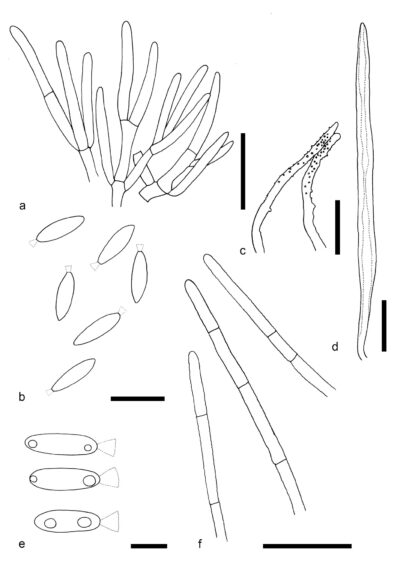Fungalpedia – Note 311, Dimorphiseta
Dimorphiseta L. Lombard & Crous
Citation when using this entry: Perera et al. 2024 (in prep) – Fungalpedia, genera described in 2016.
Index Fungorum, Facesoffungi, MycoBank, GenBank, Fig. 1
Classification: Stachybotryaceae, Hypocreales, Hypocreomycetidae, Sordariomycetes, Pezizomycotina, Ascomycota, Fungi
Lombard et al. (2016) introduced Dimorphiseta to accommodate single species that clustered sister to Smaragdiniseta in their phylogenetic analysis of cmdA, ITS, rpb2 and tub2 loci. Dimorphiseta is characterized by sporodochial conidiomata encircled by one or two types of setae that enclose an olivaceous green to dark green slimy mass of conidia. Sporodochia are stromatic, superficial, scattered to gregarious, cupulate and oval to elongate or irregular in outline. Stromas are well-developed, hyaline, and have a globulosa or angularis texture. Type I setae are hyaline, flexuous to circinate, thin, verrucose-walled, and tapered to an obtuse apex. Type II setae are hyaline, septate, thick and smooth walled and tapering to a sharp apex. Type III setae are hyaline, septate, straight, thin, smooth-walled, and terminate in an obtuse apex. Conidiophores have smooth or verrucose walls, are macronematous, irregular, verticillately or penicillately branched, hyaline, and sometimes covered by an olivaceous green mucilaginous layer. Conidiogenous cells are phialidic, cylindrical, hyaline, smooth walled and narrow at the tip. They had onspicuous collarette and periclinal thickening. Conidia are aseptate, fusiform, ellipsoidal or cylindrical, hyaline with smooth walls, and funnel-shaped mucilaginous apical appendages. However, the sexual morph remains undetermined (Lombard et al. 2016; Liang et al. 2019). Dimorphiseta is morphologically reminiscent of Smaragdiniseta, but can be distinguished by the presence of funnel-shaped mucoid conidial appendages, which are not observed in Smaragdiniseta (Rao & De Hoog 1983). Dimorphiseta species are associated with the rhizosphere soil and plant leaves (Lombard et al. 2016; Liang et al. 2019).Currently, the genus comprises of three species (Lombard et al. 2016; Liang et al. 2019).
Type species: Dimorphiseta terrestris L. Lombard & Crous
Other accepted species: Species Fungorum, search Dimorphiseta
Figure 1 – Dimorphiseta terrestris (a–d: CBS 127345, ex-type). a Conidiogenous cells. b Conidia. c Type I setae. d Type II seta. Scale bars: a–d = 10 μm. Redrawn from Lombard et al. (2016); Dimorphiseta obtusa (e, f: CGMCC3.19206, ex-type). e Conidia. f Type III setae. Scale bars: e = 2 μm, f = 50 μm. Redrawn from Liang et al. (2019)
References
Rao VG, De Hoog GS. 1983 – A new species of Myrothecium. Persoonia 12, 99–101.
Entry by
Rekhani Hansika Perera, Center of Excellence in Fungal Research, Mae Fah Luang University, Chiang Rai, 57100, Thailand.
(Edited by Kevin D. Hyde, Samaneh Chaharmiri-Dokhaharani, & Achala R. Rathnayaka)
Published online 27 August 2024
